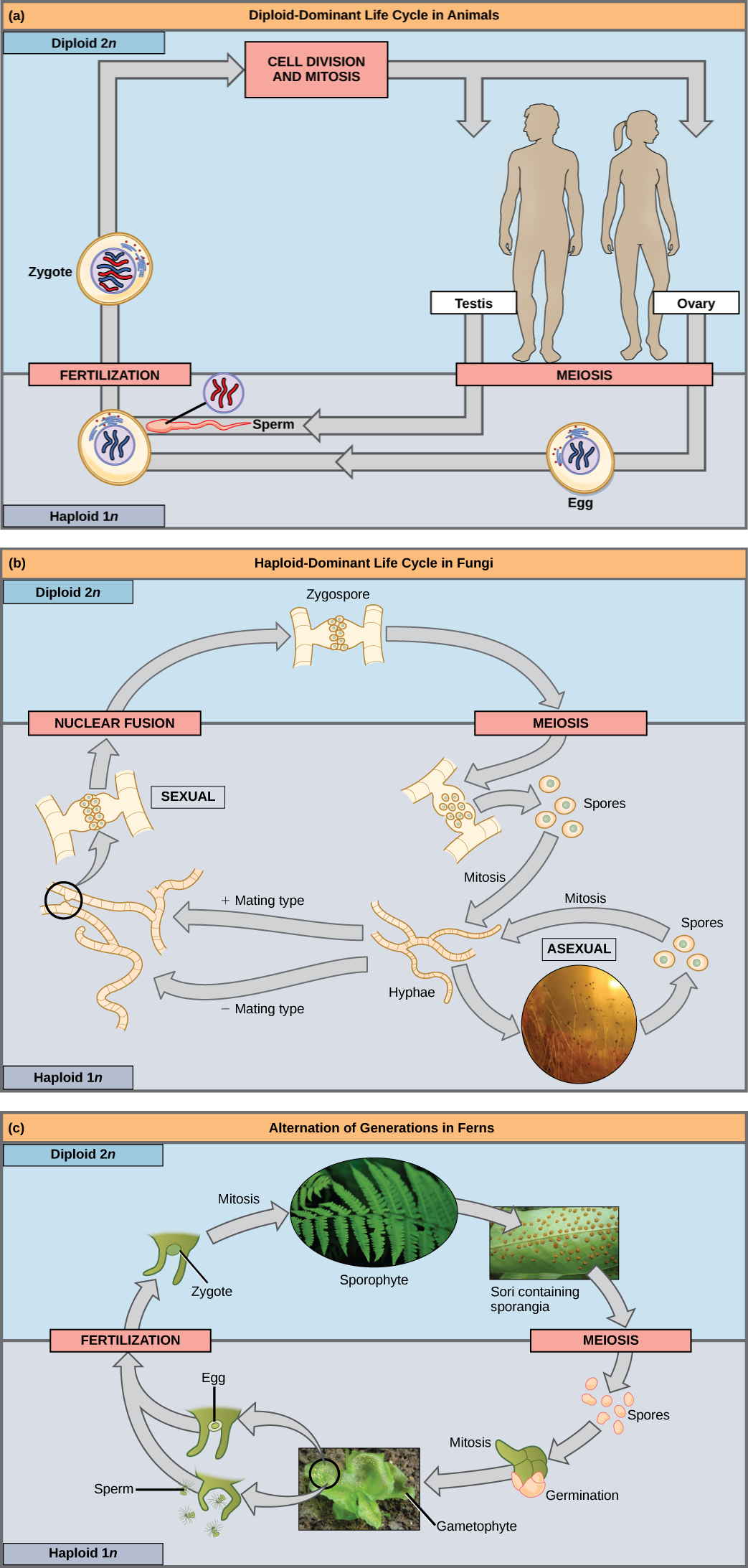| << Chapter < Page | Chapter >> Page > |
Fertilization and meiosis alternate in sexual life cycles . What happens between these two events depends on the organism. The process of meiosis reduces the resulting gamete’s chromosome number by half. Fertilization, the joining of two haploid gametes, restores the diploid condition. There are three main categories of life cycles in multicellular organisms: diploid-dominant , in which the multicellular diploid stage is the most obvious life stage (and there is no multicellular haploid stage), as with most animals including humans; haploid-dominant , in which the multicellular haploid stage is the most obvious life stage (and there is no multicellular diploid stage), as with all fungi and some algae; and alternation of generations , in which the two stages, haploid and diploid, are apparent to one degree or another depending on the group, as with plants and some algae.
Nearly all animals employ a diploid-dominant life-cycle strategy in which the only haploid cells produced by the organism are the gametes. The gametes are produced from diploid germ cells , a special cell line that only produces gametes. Once the haploid gametes are formed, they lose the ability to divide again. There is no multicellular haploid life stage. Fertilization occurs with the fusion of two gametes, usually from different individuals, restoring the diploid state ( [link] a ).

If a mutation occurs so that a fungus is no longer able to produce a minus mating type, will it still be able to reproduce?
Most fungi and algae employ a life-cycle strategy in which the multicellular “body” of the organism is haploid. During sexual reproduction, specialized haploid cells from two individuals join to form a diploid zygote. The zygote immediately undergoes meiosis to form four haploid cells called spores ( [link] b ).
The third life-cycle type, employed by some algae and all plants, is called alternation of generations. These species have both haploid and diploid multicellular organisms as part of their life cycle. The haploid multicellular plants are called gametophytes because they produce gametes. Meiosis is not involved in the production of gametes in this case, as the organism that produces gametes is already haploid. Fertilization between the gametes forms a diploid zygote. The zygote will undergo many rounds of mitosis and give rise to a diploid multicellular plant called a sporophyte . Specialized cells of the sporophyte will undergo meiosis and produce haploid spores. The spores will develop into the gametophytes ( [link] c ).
Nearly all eukaryotes undergo sexual reproduction. The variation introduced into the reproductive cells by meiosis appears to be one of the advantages of sexual reproduction that has made it so successful. Meiosis and fertilization alternate in sexual life cycles. The process of meiosis produces genetically unique reproductive cells called gametes, which have half the number of chromosomes as the parent cell. Fertilization, the fusion of haploid gametes from two individuals, restores the diploid condition. Thus, sexually reproducing organisms alternate between haploid and diploid stages. However, the ways in which reproductive cells are produced and the timing between meiosis and fertilization vary greatly. There are three main categories of life cycles: diploid-dominant, demonstrated by most animals; haploid-dominant, demonstrated by all fungi and some algae; and alternation of generations, demonstrated by plants and some algae.
[link] If a mutation occurs so that a fungus is no longer able to produce a minus mating type, will it still be able to reproduce?
[link] Yes, it will be able to reproduce asexually.

Notification Switch
Would you like to follow the 'Concepts of biology' conversation and receive update notifications?